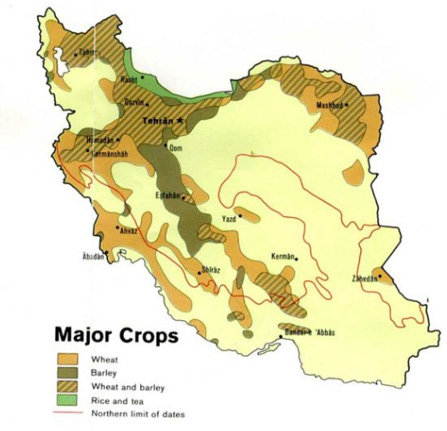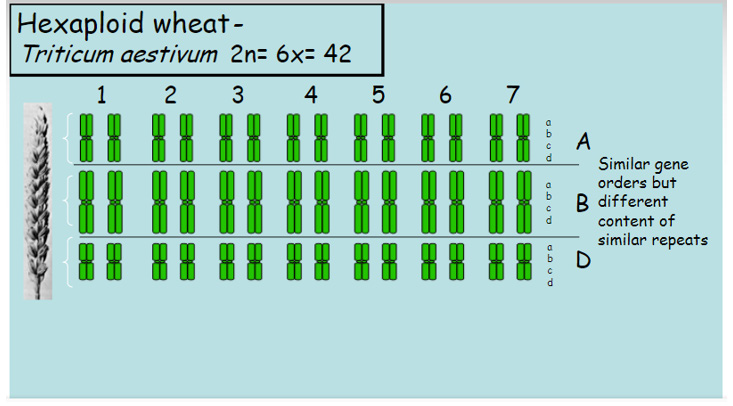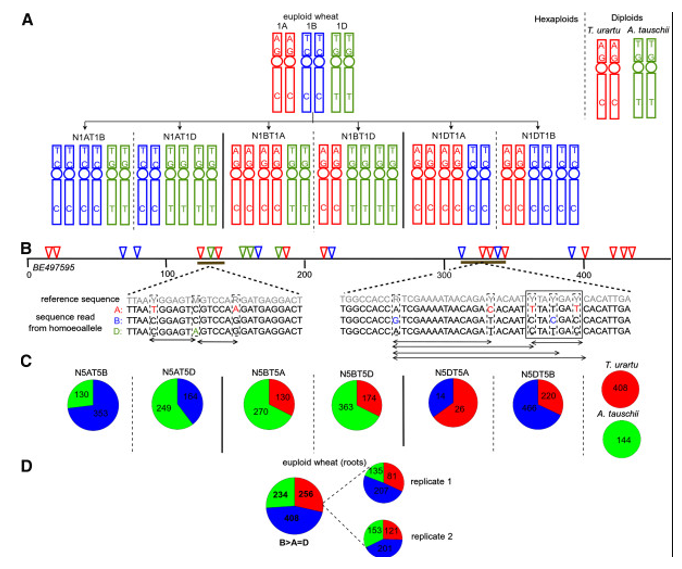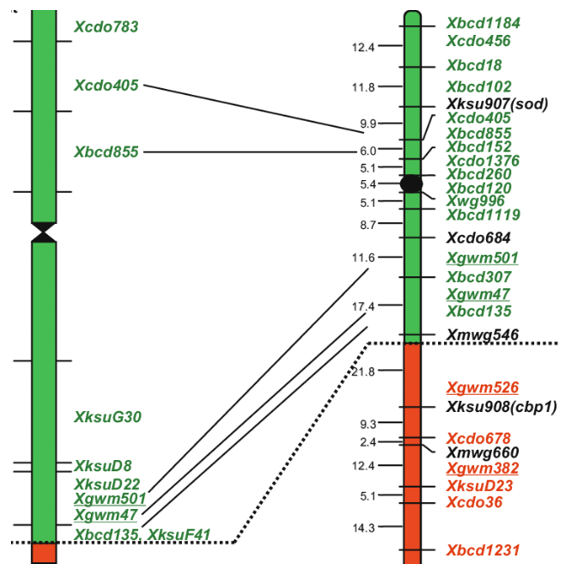Mini Review 
 Creative Commons, CC-BY
Creative Commons, CC-BY
General Hexaploid, Tetraploid and Diploid Wheat Production in Iran
*Corresponding author: Hamid Kheyrodin, Assistant professor, Semnan University, Iran.
Received: December 29, 2024; Published: January 09, 2025
DOI: 10.34297/AJBSR.2025.25.003323
Abstract
Genetic variation in wheat can be introduced through conventional and modern approaches. The traditional breeding approach includes introducing improved traits from other elite lines, but also from wild relatives and landraces when the elite line parents do not have genetic variation for important or desired traits. Bread wheat (Triticum aestivum, genome BBAADD) is a young hexaploid species formed only 8,500-9,000 years ago through hybridization between a domesticated free-threshing tetraploid progenitor, genome BBAA, and Aegilops tauschii, the diploid donor of the D subgenome. Triploidy is defined as a genetic condition characterized by the presence of three copies of each chromosome. It often results from fertilization of the egg by two sperm or abnormal chromosome separation during maternal meiosis, leading to high rates of spontaneous abortion and rare live births with severe malformations.We concluded that The plant of Triticum aestivum is (a) Haploid,(b) Diploid,(c) Tetraploid,(d) Hexaploid. Triticum aestivum is characterized by having collated roots, with seminal and adventitious roots. The seminal roots are people who originate, in numbers from 3 to eight, directly from the embryo; these are thin, very rich in the root, and really branched hairs. Triticum turgidum poorly tolerates aneuploidy, and monosomics are difficult to produce and maintain. A set of disomic substitution lines of the D-genome chromosomes for their A and B genome homoeologues serves a similar role in tetraploid wheat as monosomics in hexaploid wheat. In this work we estimated the number of genes in the hexaploid wheat genome to range between 94,000-96,000
Keywords: Wheat genome, Hexaploid, Tetraploid and diploid
Introduction
According to this report, Iran produced over 13 million tons of wheat in 2022 and 13.5 million tons in 2023. FAO put Iran’s total cereal stocks at 12.1 million tons in the previous year, noting that the stocks increased by 100,000 tons compared to the previous year Figure 1 [2].
Hexaploid wheat possesses 42 chromosomes derived from its three ancestral genomes. The 21 pairs of chromosomes can be further divided into seven groups of six chromosomes (one chromosome pair being derived from each of the three ancestral genomes), based on the similarity of their gene order. T. aestivum L. is hexaploid (AABBDD) with an entire 42 chromosomes (2n=42), sixfold seven chromosomes) Figure 2. Similarly, the varied wheat species also contain some multiple of the essential haploid set of seven chromosomes Table 1.
Wheat is one of the world’s most consumed cereal grains. It comes from a type of grass (Triticum) that is grown in countless varieties worldwide. Bread wheat, or common wheat, is the primary species. Several other closely related species include durum, spelt, emmer, einkorn, and Khorasan wheat. White and whole-wheat flour are key ingredients in baked goods, such as bread. Other wheatbased foods include pasta, noodles, semolina, bulgur, and couscous. Wheat is highly controversial because it contains a protein called gluten, which can trigger a harmful immune response in predisposed individuals Figure 3. However, for people who tolerate it, whole-grain wheat can be a rich source of various antioxidants, vitamins, minerals, and fiber. Milling is the process by which cereal grains are ground into flour [5].
Figure 3, Hard red and hard white wheat is best for yeast breads. Soft wheat is best used in cakes, pastries and other baked goods, as well as crackers and cereal [1]. Durum wheat is the hardest of all wheat and makes the best pasta.
Wheat is the world’s third cereal crop and provides more than 20% of the calories consumed by humans (Dubcovsky & Dvorak, 2007; FAO, 2013). There are six species of wheat at three different ploidy levels: the diploid species T. monococcum (AmAm) and Triticum urartu (AA); the tetraploid species Triticum turgidum (BBAA) and Triticum timopheevii (GGAA); and the hexaploid species Triticum aestivum (BBAADD) and Triticum zhukovskyi (GGAAAmAm). The evolution of loss of seed dispersal in domesticated wheat is much more complicated than for other cereal crops, mainly due to its complex domestication process and inflorescence structure. For example, hybridizations and whole genome duplications of three diploid species, T. urartu, Aegilops speltoides (SS), and Aegilops tauschii (DD), have led to the establishment of tetraploid emmer (T. turgidum) and hexaploid bread (T. aestivum) wheats. Similarly, multiple rounds of polyploidy followed by domestication have resulted in another distinct wheat lineage comprising T. monococcum, T. timopheevii, and T. zhukovskyi.
Hexaploid wheat possesses 42 chromosomes derived from its three ancestral genomes. The 21 pairs of chromosomes can be further divided into seven groups of six chromosomes (one chromosome pair being derived from each of the three ancestral genomes), based on the similarity of their gene order Figure 4. [6] “Triticum taxonomy”. Mansfeld’s World Database of Agricultural and Horticultural Crops.
Triploidy in Plants
Triploidy is encountered ocassionally in natural populations of flowering plants where both diploid (2n) and tetraploid (4n) populations exist. It is presumed that such triploids arise by natural crosses between diploid and tetraploid plants in the same population. However, there are many examples of triploid strains of cultivated plants that have been induced artificially by crossing diploid and tetraploid parental strains. Unlike human triploids, such triploid plants appear to be morphologically normal, but are characterized by being completely infertile and can only be reproduced by vegetative mechanisms [4]. Their infertility arises during gamete formation and results in what the consumer perceives to be ‘seedless’ fruit (i.e., seeds are still present but they are greatly reduced in size and are not viable). Typically, during meiosis the three copies of each chromosome join and crossover to produce a trivalent at the first meiotic division. The resulting chromosome segregation from each trivalent is completely random, and it is extremely unlikely that a sufficiently large number of genetically balanced gametes can be produced to provide fertility. This phenomenon of triploid sterility was widely studied in the 1930s and 1940s in various plant species with notable contributions from Darlington and Mather in triploid Hyacinthus (hyacinth) and Dermen in Petunia by studying chromosome segregation in pollen. One of the most famous and ancient examples of a triploid plant species is the cultivated banana characterized by its widely used and fleshy ‘seedless’ fruit. The cultivated banana is believed to have been derived from a cross between the diploid species Musa acuminata and the tetraploid species Musa balbisiana, both of which produce seeded fruit, some 1000 years ago in Southeast Asia.
Commercial Varieties and Transgenic Potatoes
There are more than 150 wild species of potato found in Central America, Mexico, and the USA. S. tuberosum L. (tetraploid) represents the cultivated species and there are seven other cultivated species, including S. ajanhuiri, S. goniocalys, S. phureja, S. stenotomum (diploids), S. × juzepczukii, S. × chaucha (triploids), S. × curtilobum (pentaploid), which are grown in different parts of Peru, Bolivia, Ecuador, and Venezuela. Many improved local varieties have been developed and introduced in several countries and these may show increased yield, disease resistance, better tuber shape, texture, and quality for processing as well as flavor.
In recent years, attempts have also been made worldwide to generate transgenic potato plants and assess the impact of transgenic expressions on diverse parameters such as yield, quality, carbohydrate metabolism, stress physiology, and pest and disease resistance. The outcome of the transgenic approach is promising and already insect- and herbicide-resistant potato plants are in commercial use.
Conclusion
Hexaploid wheat (Triticum aestivum L.) is derived from a complex hybridization procedure involving three diploid species carrying the A, B and D genomes. The proteome patterns of diploid, tetraploid and hexaploid wheat were analyzed to explore the genome interaction in protein expression. Previous studies have revealed that, during anther development, the chromosomes associate in 21 pairs via their centromeres. The present study reveals that, as a prelude to meiosis, these 21 chromosome pairs in hexaploid (and tetraploid) wheat associate via the centromeres into seven groups as the telomeres begin to cluster [3]. This results in the association of multiple chromosomes, which then need to be resolved as meiosis progresses.
The world’s four most important crops provide examples of the range of ploidy levels found in plants. Bread wheat is a hexaploid (2n=6x=42), derived as little as 30,000 years ago from a diploid species (2n=2x=14), Aegilops squarrosa, and a tetraploid, durum wheat (2n=4x=28), Triticum turgidum, itself derived from two diploid species T. monococcum and a species similar to Ae. Speltoides Figure 2 and 3. The second most important crop, rice, is considered diploid, while molecular mapping data, the fertility of monosomic chromosome lines, cytogenetic comparisons with wild species, and some chromosome pairing data show that maize, the third most important crop, is a paleotetraploid. Banana, the fourth most important crop, is cultivated as a triploid hybrid to give sterile fruit with parthenocarpic development. A few ‘new’ crops have been generated as man-made hybrids: the wheat × rye amphidiploid Triticale is widely grown in dry and colder areas of Canada and Poland. In horticulture, polyploids, whether species, natural, or artificial hybrids, are widely selected by breeders, perhaps because they tend to be larger than the equivalent diploid.
Acknowledgments
The authors acknowledge the Research station of Semnan University for providing the funding to complete this work.
References
- Akhtar N, Chowdhry MA (2006) Genetic analysis of yield and some other quantitative traits in bread wheat. Int J Agric Biol 4: 523- 527.
- Baqizadeh A (2003) Environmental management related pages have been shown to you by permissibility and molecular markers. The thesis of the Plant Breeding Physician University of Tehran.
- Caligari PDS, Brandham PE (2001) Wheat taxonomy: the legacy of John Percival (PDF) (Linnean Special Issue 3edn.). London: Linnean Society. pp. 190.
- Chen XM, Line RF (1995) Gene number and heritability of wheat cultivars with durable high temperature, adult plant (HTAP) resistance interaction of HTAP and race specific seedling resistance to Puccinia striiformis. Phytopathology 85: 573-578.
- Ghannadha MR (1998) Gene action for latent period of stripe rust in five cultivars of wheat. Iranian J Crop Sci 1: 53-71.
- (2006) Triticum taxonomy. Mansfeld's World Database of Agricultural and Horticultural Crops.








 We use cookies to ensure you get the best experience on our website.
We use cookies to ensure you get the best experience on our website.